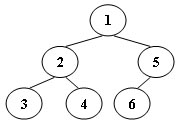An inorder binary tree traversal can be implemented in a non-recursive way with a stack. For example, suppose that when a 6-node binary tree (with the keys numbered from 1 to 6) is traversed, the stack operations are: push(1); push(2); push(3); pop(); pop(); push(4); pop(); pop(); push(5); push(6); pop(); pop(). Then a unique binary tree (shown in Figure 1) can be generated from this sequence of operations. Your task is to give the postorder traversal sequence of this tree.
Figure 1
Input Specification:
Each input file contains one test case. For each case, the first line contains a positive integer N (≤30) which is the total number of nodes in a tree (and hence the nodes are numbered from 1 to N). Then 2N lines follow, each describes a stack operation in the format: "Push X" where X is the index of the node being pushed onto the stack; or "Pop" meaning to pop one node from the stack.
Output Specification:
For each test case, print the postorder traversal sequence of the corresponding tree in one line. A solution is guaranteed to exist. All the numbers must be separated by exactly one space, and there must be no extra space at the end of the line.
Sample Input:
6
Push 1
Push 2
Push 3
Pop
Pop
Push 4
Pop
Pop
Push 5
Push 6
Pop
Pop
Sample Output:
3 4 2 6 5 1
一,主要思想
入栈顺序即为先序遍历的顺序,出栈顺序即为中序遍历的顺序,根据进栈1 2 3 4 5 6 和出栈 3 2 4 1 6 5可以确定一个唯一的二叉树。
二,关于输入的写法
scanf("%d", &n);
for (int i = 0; i < 2 * n; i++) {
scanf("%s", str);
if (strcmp(str, "Push") == 0) {
scanf("%d", &num);
pre_arr[pre_index++] = num;
sta.push(num);
}
else{
num = sta.top();
sta.pop();
in_arr[in_index++] = num;
}
}即首先利用scanf() 输入字符串时遇到空格等符号时会自动停止输入,然后用strcmp()比较即可。
三,正确代码
#include<cstdio>
#include<string.h>
#include<stack>
using namespace std;
//到17:05
int n = 0;
int times = 0;
int pre_arr[40] = { 0 };
int in_arr[40] = { 0 };
struct node {
int data;
node *lchild;
node *rchild;
};
stack<int> sta;
node *create(int preL,int preR,int inL,int inR) {
if (preL > preR) {
return NULL;
}
node *root = new node;
root->data = pre_arr[preL];
int k;
for (k = inL; k <= inR; k++) {
if (pre_arr[preL] == in_arr[k]) {
break;
}
}
int numLeft = k - inL;
root->lchild = create(preL + 1, preL + numLeft, inL, k - 1);
root->rchild = create(preL + numLeft + 1, preR, k + 1, inR);
return root;
}
void posOrder(node *tree) {
if (tree == NULL) {
return;
}
posOrder(tree->lchild);
posOrder(tree->rchild);
printf("%d", tree->data);
times++;
if (times != n) {
printf(" ");
}
}
int main() {
char str[6];
int num = 0;
int pre_index = 0;
int in_index = 0;
scanf("%d", &n);
for (int i = 0; i < 2 * n; i++) {
scanf("%s", str);
if (strcmp(str, "Push") == 0) {
scanf("%d", &num);
pre_arr[pre_index++] = num;
sta.push(num);
}
else{
num = sta.top();
sta.pop();
in_arr[in_index++] = num;
}
}
node *tree = create(0, n - 1, 0, n - 1);
posOrder(tree);
return 0;
}